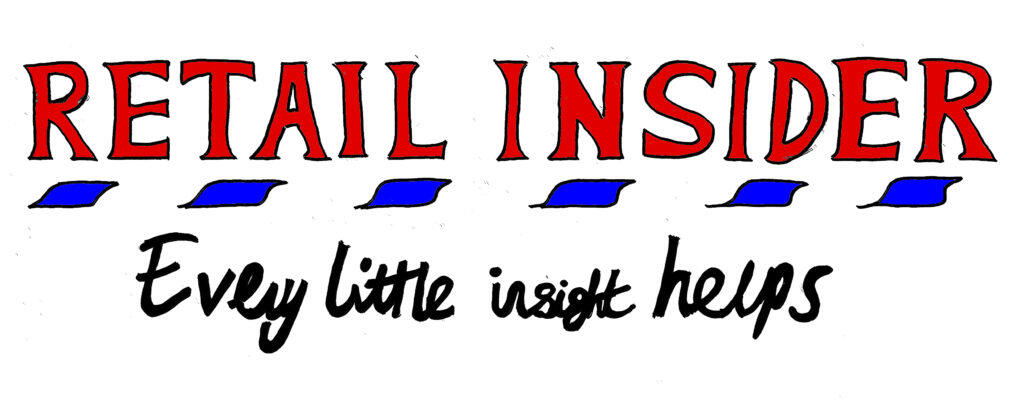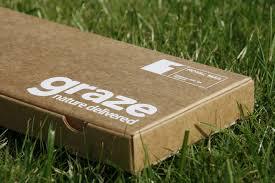Innovative Retailer – Graze.com
The Name: Graze
The Place: Through your letterbox – so anywhere in the UK and now launched in the US too.
The Story: Snacks are very big business, agreed?
I should coco. You can’t move for family bags of salted nuts in my house: OK, what about super kale and edamame bean snacks?
Well, slightly less of those perhaps. But plenty of prawn cocktail crisps: Right, how about rhubarb and custard?
That’s not a snack, that’s a dessert: Mumbai Masala?
Sounds like dinner: Boston Baguette?
To be brutally honest I’m not sure we are on the same snacking wavelength here: What if I say that Mumbai Masala is chilli and lime-infused cashews with baked curry bites and spicy chickpeas.
Ha! So flavoured nuts after all. Now you’re talking sense. What’s prune and rhubarb compote when it’s at home? Custard-coated raisins with slices of dried rhubarb.
Boston Baguette – dare I ask? Barbeque relish with tomato breadsticks.
OK, now that I would actually eat: Thank God, then we can move on. There are around 100 different quirkily-named snacks on the Graze website – some are very healthy, some are unhealthy sounding like deconstructed carrot cake but are in fact healthy and some just are what they say – like a chocolate brownie with dipping sauce or banoffee pie. But the important thing is that even the unhealthy ones will not be killing you because they are all snack size.
You mean small: Yes. The range changes constantly with seasonal additions (the limited edition mince pie flapjacks are just on for example) as new ideas are developed but the company’s driving aim according to CEO Anthony Fletcher is to make healthy exciting.
Good luck with that: Luck is not required. This company which has only been going since around 2010 had an annual turnover of £70m last year.
That’s a lot of breadsticks: It surely is but the element of excitement for the consumer is not merely from the ever changing mix of eccentrically named products. The innovation is that Graze is a box delivery service.
Meaning…. Meaning you choose how often you receive the box through the door (weekly, bi-weekly, monthly etc) and after indicating basic preferences or allergies, they do the choosing for you. The customer does not know exactly what will be in the box from one delivery to the next.
A secret surprise goody box with healthy snacks delivered to my door. I like it: Many, many people like it. And children like the kids version even more.
So, CEO Fletcher. What of him? He comes via the technological innovation breakthrough of LoveFilm and the brand-heavy heritage of Innocent Drinks so he knows a thing or three about this brand building business and cleverly using technology. He had been planning to do his own thing but after seeing an early stage development box of Graze he was in and joined the business in 2009.
And the holy grail of retailing – a subscription model too: Fletcher calls the mechanism ‘subscription–lite’ meaning it is extremely easy to get in or out of unlike some other such models. But he admits that it needs to be this way because people do get bored of Graze, the novelty wears off and they leave the service, but the winning aspect is that a large number of them will come back again at some point.
The long view: Exactly. It’s a very agile brand, if the market moves and customer preferences change then it can turn on a sixpence to reflect that. A large FMCG company will spend millions on launching one new product into the snack market. The food scientists at Graze have created hundreds of new products which may be produced only once. Failing is not expensive at Graze and in fact can only be helpful to refine the range and really pinpoint where consumer taste is at.
And just out of interest – the most popular ones are? By and large those that help the customer not to eat crisps or sweets if that helps.
Well, kind of. Anyway back to the company history: As Fletcher points out something clicked for the company in 2010 and the two components of a) understanding how to make healthy snacks ‘exciting’ and b) the technology aspect came together.
And to be clear who supplies all the products? Graze has hundreds of suppliers from tiny bakers in Devon to large global producers. The supply chain is automated from its headquarters in Richmond and can react very quickly to any changes in the market.
And who makes the end product? Graze designs the snacks based around the products they have and as Fletcher claims they are probably the quickest weighers of products in the world as everything has to be packed into the small snack size plastic containers to an exact weight. At £1 per punnet (there are 4 punnets in the average Graze box) that is 70 million little boxes to be packed from its headquarters every year.
So what next for the snack meisters? Some branching out of the box model is taking, children’s boxes are proving popular, there are now sharing boxes and chocolate-only boxes too. And of course there is the sizeable matter of the US market.
Ah yes, how do the original big eaters take to the 39g box of treats? The snack market is indeed vast in the US but Graze found two enormous initial problems. First they do not market foods in the same way as we do in the UK, and second is the idiosyncrasies of the American postal system.
What’s wrong with it? Americans only use it to send letters, 77% of what they deliver is flat. They are unused to delivering parcels and boy, does it show. Graze entered the postal system via New Jersey and did trial runs sending out 40,000 cardboard rabbits with tracking codes attached. Some took days to arrive, some took weeks. Some even took a fortnight to get to Manhattan just over the river.
Oh dear. Solution? They were invited to meet the Postmaster General to discuss the data.
Crikey: And each quarter they share their data with the US postal people. Having cleverly worked out how to get around this issue parcels are now getting through as US sales amounted to $34 million in the first year of operation making the US branch profitable within 12 -14 months. But success leads to competition.
Blighters. How many? Around 30 globally. One US version raised $60 million in order to compete with Graze. In the UK there are around 10 to 15 but they come and go with some rapidity. However Graze is still comfortably number one so when the big retail names wanted healthy snacks to sell in-store guess who they came to.
Big names being… Sainsbury’s, Boots, and WH Smith to name a few. Fletcher is very happy with the mix of online and physical and says that two channels are always stronger than one. It’s only been three months but Graze is very excited about this. And guess what.
Can’t guess. What? Customer data from the loyalty cards shows that these store shoppers are completely different to the box buyers – for instance a high proportion of them never bought snacks like crisps at all before.
There are people who never bought crisps before? They went straight for super kale and edamame beans? That’s a bit hardcore – current in-store offerings are a little more welcoming. Think Thai sweet chilli dippers and dark chocolate cherry tart (that’s chocolate buttons, cherries, cranberries and raisins to you).
Go on then. I’m in: Lovely, now can I tempt you with a subscription.
PCMS is a global provider of IT software, specialising in retail services, including point of sale (PoS) software, contact centre and IT support services. It is a pioneer in developing mobile retail solutions, including customer shopping apps and mobile PoS. Its client list includes John Lewis, Marks & Spencer, Waitrose, Whole Foods, as well as Walgreens in the US and fashion brands including Prada and Ferragamo across Europe.




